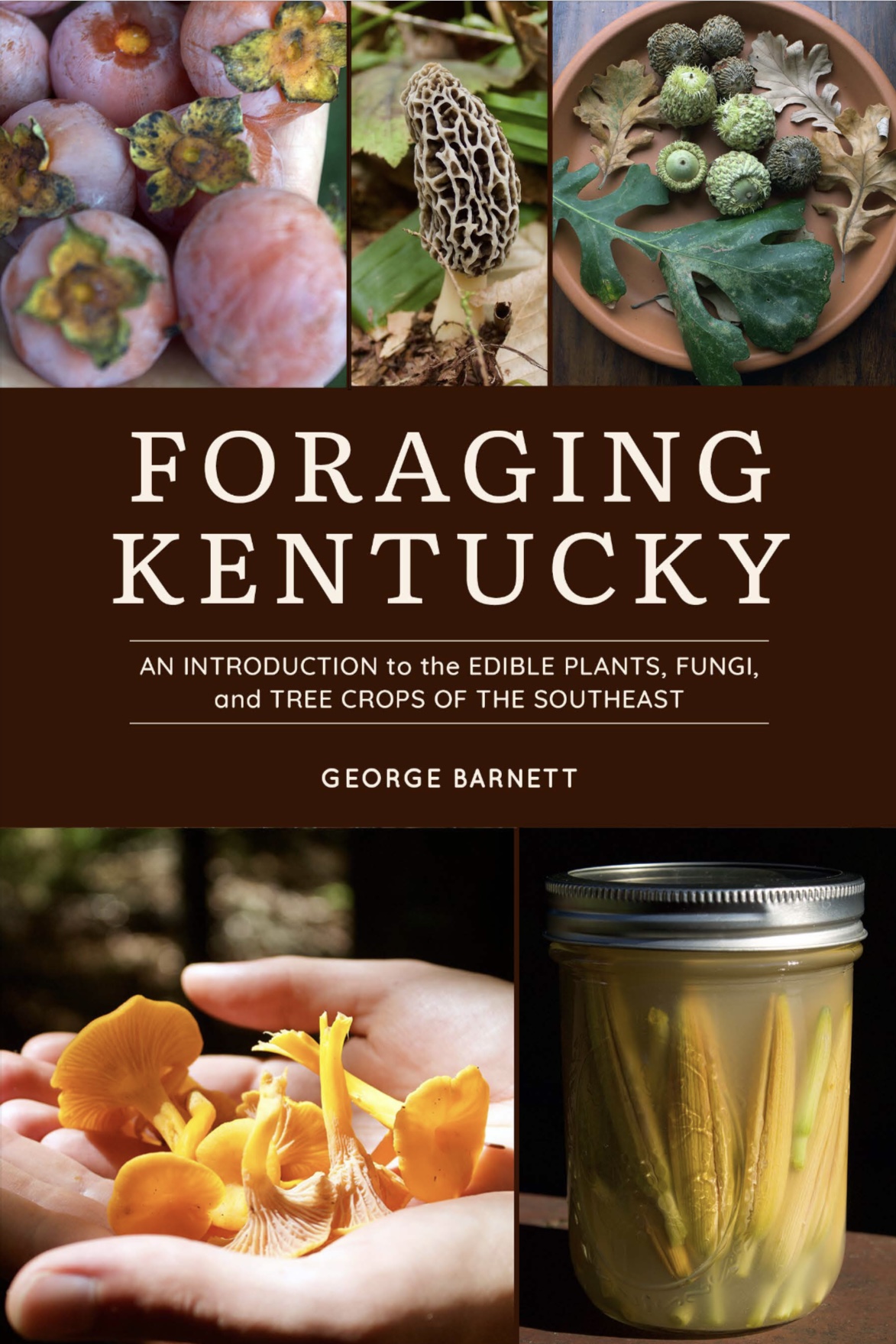
The book is available for purchase here.
Official release date: April 2nd, 2024
Foraging Kentucky:
An Introduction to the Edible Plants, Fungi, and Tree Crops of the Southeast
With rich soils, thousands of creeks, and twelve major river basins, the state of Kentucky is abundant with wild edibles that not only are delicious but also can be useful for medicinal purposes. Various species of wildflowers such as spring beauty, edible fungi like chanterelles, and tree crops such as hickory nuts may be foraged and pickled, steamed, candied, or stir-fried to create an enticing, healthy, and substantial meal.
Foraging Kentucky is an expansive beginners' guide to safely and ethically foraging in the state. The species covered in the book are divided into three categories: herbaceous plants, fungi, and woody plants. Author, forager, and environmental educator George Barnett shares his extensive knowledge on the proper identification of the featured species, where and when they grow, and how to harvest and prepare them for consumption. Complete with high-definition color photographs, recipes, and short history lessons, this guide is chock-full of crucial information for readers who want to forge an enlightening relationship with the delectable foods naturally available in Kentucky's great outdoors.
Praise for Foraging Kentucky
"Drawing on scientific studies, indigenous knowledge, folklore, and his own long experience, George Barnett has provided us with an informative and useful guide to some of Kentucky’s most popular wild edibles, as well as several unheralded species that perhaps deserve more attention. His descriptions of some 50 herbs, fungi, and woody plants include wonderful photographs and detailed instructions for every step of the foraging enterprise, from how to find and harvest them to how to eat them. Anyone with any interest in foraging in and around the commonwealth should have Foraging Kentucky on their shelf."
— Luke Manget, author of Ginseng Diggers: A History of Root and Herb Gathering in Appalachia, a winner of the 2023 W.D. Weatherford and James A. Duke Awards.
"George Barnett shows that with this book he is not only knowledgeable, but has immeasurable wisdom about the forests and the wild areas of Kentucky. We should all consider ourselves lucky to have this edition to add to our library shelves. Foraging for food is at an all time high in popularity right now, and it is thanks to the hard work and dedication of people like George."
―Clay Bowers-Michigan, foraging teacher and nature enthusiast
"While covering awesome native food plants like hickory and eastern camas, it's nice that George also includes non-native foods like wineberry and autumn olive. Combining wild edible plants and edible/medicinal mushrooms makes this book stand out in a fun and exciting way!"
―Jed Arkels, small nursery grower/owner of Drop Seed Ecology, and wild foods enthusiast
"Barnett delivers an approachable, yet practical perspective on foraging in the region. He guides the reader with knowledgeable and personal experience― along with over 200 descriptive photos―that will help the beginner forager to head out into the woods with confidence. This invitation to the wild of Kentucky, through mushrooms, edible plants and herbs, introduces the reader to the edible outdoors with notes of identification, safety, practical uses, sustainability while also inspiring a reverence to the land. A must have for Kentucky foragers!"
―Jess Starwood, author of Mushroom Wanderland
"If you care about eating local and living lightly on the land, Foraging Kentucky needs to be in your backpack. This book is an important reminder that our Commonwealth is a place of incredible abundance, if we learn to simply recognize it. Barnett invites us to slow down, discover our natural heritage, and indulge in the common wealth that our land offers."
~Justin Mog, Ph.D., Assistant to the Provost for Sustainability Initiatives at the University of Louisville

TABLE OF CONTENTS:
Preface
Introduction
Disclaimers: Harvesting & Consuming Wild Foods Safely
Wild Mushroom Preservation Techniques
1. Part One: Herbaceous Plants
Spring Beauty / Claytonia virginica
Chickweed / Stellaria spp.
Wild lettuce / Lactuca spp.
Violet / Viola spp.
Aniseroot / Osmorhiza longistylis
Wild Hyacinth / Camassia scilloides
Wood Nettle / Laportea canadensis
Wild/Field Garlic / Allium vineale
Common Dittany / Cunila origanoides
Toothwort / Cardamine spp.
Garlic Mustard / Alliaria petiolata
Tawny Daylily / Hemerocallis fulva
Wood Sorrel / Oxalis spp.
Wild Bergamot / Monarda fistulosa
Wintergreen / Gaultheria procumbens
2. Part Two: Mushrooms
Morel / Morchella spp.
Turkey Tail / Trametes versicolor
Chanterelle / Cantharellus spp.
Puffballs / Lycoperdon spp.
Oyster / Pluerotus spp.
Eastern Hemlock Reishi / Ganoderma tsugae
Black Trumpet / Craterellus fallax
Chicken of the Woods / Laetiporus spp.
Wood Ear / Auricularia fuscosuccinea
Indigo Milkcap / Lactarius indigo
Hen of the Woods / Grifola frondosa
Lion's Mane / Hericium spp.
3. Part Three: Woody Plants
Eastern Black Walnut / Juglans nigra
Hickory / Carya spp.
American Beech / Fagus grandifolia
Sassafras / Sassafras albidum
American Persimmon / Diospyros virginiana
Hackberry / Celtis spp.
Eastern White Pine / Pinus strobus
Serviceberry / Amelanchier spp.
Elderberry / Sambucus spp.
Black Locust / Robinia pseudoacacia
Eastern Redbud / Cercis canadensis
Autumn Olive / Elaeagnus umbellata
Eastern Red Cedar (Juniper) / Juniperus virginiana
Pawpaw / Asimina triloba
Blueberry & Black Huckleberry / Vaccinium spp. & Gaylussacia baccata
Black Raspberry / Rubus occidentalis
Wineberry / Rubus phoenicolasius
Mulberry / Morus spp.
Oak / Quercus spp.
Afterword: Become a mycorrhizal species
Acknowledgements
Recommended Reading
Glossary
Bibliography
Index
6x9"
272 Pages
Written by The Hungry Forager’s George Barnett
Published by The University Press of Kentucky
